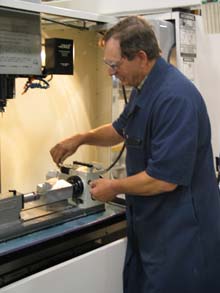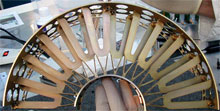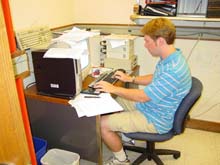 |
Friday, October 6
3:30 p.m.
DIRECTOR'S COFFEE BREAK - 2nd Flr X-over
4:00 p.m. Joint Experimental Theoretical Physics Seminar -
1 West
Speaker: A. Gupta, University of Chicago
Title: W Mass and Width from LEP
Monday, October 9
2:30 p.m. Particle Astrophysics Seminar - Curia II
Speaker: K. Abazajian, University of Maryland
Title: Dark Matter in the Neutrino Sector: Sterile Neutrinos
3:30 p.m. DIRECTOR'S COFFEE BREAK - 2nd Flr X-Over
4:00 p.m. All Experimenters' Meeting - Curia II
Special Topic: DZero Luminosity
Saturday, October 7
10:00 p.m. - 2:00 p.m. Prairie Harvest
Click here for a full calendar with links to additional information.
|



Friday, October 6
-New England Clam Chowder
-Black & Blue Cheese Burger
-Mardi Gras Jambalaya
-Swedish Meatballs
-Bistro Chicken & Provolone Panini
-Assorted Slice Pizza
-Carved Top Round of Beef
Upcoming Menu
|
 |
Wednesday, October 11
Lunch
-Rouladen
-Buttered and Dill Egg Noodles
-Steamed Carrots w/Garlic & Thyme
-Apple Walnut Cake
Thursday, October 12
Dinner
-Tapas
-Sangria
-Stuffed Mussels/Grilled Squid
-Grilled Prawns
-Chicken Liver Timbale w/Sherry Mayo
-Tarta de Hongos
-Pork Pimento Turnovers
-Marinated Oranges w/Gran Marnier
Chez Leon Menu
Call x4598 to make your reservation.
|


|
 |
| On the job with Parkhurst: Sculpting metal for CMS
|
 |
|
Harry Parkhurst uses machines to translate engineers' plans into reality. The platform above will oscillate around a drill (top left), boring holes with perfect angles and dimensions.
|
|
|
Working in the Fermilab machine shop, machinist Harry Parkhurst sets an aluminum slab on a platform inside a milling machine. Sparks fly as he lowers a drill to touch the slab, and the platform and slab begin to gyrate like a hoola-hoop around the drill. "It angles the hole in two different directions," Parkhurst explained.
It's Parkhurst's job to translate plans into reality. "The [engineer's] drawing only describes the product, it doesn't tell you how to get there," he said. Parkhurst interprets the drawings, and programs a computer to execute the steps needed to make each angle and dimension perfect. When complete, his latest project, a set of tubes, will carry coolant through the CMS detector. First, however, Parkhurst had to figure out how the slab should gyrate under the drill to make holes that twist in one direction, and then another.
To build the cooling system, Parkhurst will bore two of these holes into about one hundred slabs, each hole connecting with the ends of a U-shaped trough down the slab's center. He'll sandwich the troughs together in pairs to form a hollow space, and mill aluminum away until only half a millimeter of metal surrounds each channel (see photo below). The hollow spaces will connect where Parkhurst drilled curved holes, creating a continuous tube. "It comes out feather-light," he said. "Coolant goes in one tube, around and down to the other."
"This type of work highlights the interaction between the machinist, the engineer and the user," said Parkhurst's boss, Charles Matthews. "It's just a lot of geometry," Parkhurst added. "Geometry and dimensions."
--Siri Steiner
|
 |
|
Fluorocarbon will flow through these U-shaped channels to keep CMS electronics operating at -10 degrees Celsius.
"Without cooling, the temperature of the electronics mounted directly on the silicon pixels could be high enough to
prevent normal operation," said physicist Bruno Gobbi, who helped work on sketches for the design.
|

The Economist,
September 28:
The light fantastic: A way of building particle accelerators on a table top
HIGH-ENERGY particle physicists like to smash things together, break them open and see what is inside. It is a good way of working out what the world is really made of, but it has its limits. The faster you hurl things, the more you find out. But the apparatus needed to hurl things fast enough to interest today's physicists is huge and horrifyingly expensive. The Large Hadron Collider (LHC), now being built near Geneva in a tunnel 27km (17 miles) in circumference, is expected to have cost SFr10 billion ($8 billion) by the time it opens next year.
In their heart of hearts, many particle physicists fear that the LHC will be the last big accelerator built. Their subject, intellectually important though it undoubtedly is, has little practical application. It may therefore become too expensive for taxpayers to sustain. However, a paper just published in Nature Physics by Wim Leemans of the Lawrence Berkeley National Laboratory in California and Simon Hooker of Oxford University may offer the subject a way out. For Dr Leemans and Dr Hooker describe a device that might cut costs drastically.
Read More |
|  |

| Students contribute to ILC damping ring studies |
 |
| Michael Ehrlichman, a senior at the University of Minnesota, analyzed intrabeam scattering in the CESR test facility. |
Between electron cloud concerns, ultra-low beam emittance requirements and a handful of wigglers, you might say that the damping rings in the International Linear Collider are high maintenance. In the ILC, the 6-kilometer round damping rings will transform loose bunches of electrons and positrons into tight, disciplined beams before their final acceleration toward the interaction point at the center of the machine. It sounds easy enough, but fine-tuning the beams to be less than the thickness of a human hair is an extremely complex and challenging task.
In order to optimize the performance of the damping rings and at the same time minimize the cost, test facilities, such as the Accelerator Test Facility at KEK, are necessary to study important physics and technology issues. At Cornell University, a proposal is underway to convert the Cornell Electron Storage Ring (CESR), which is scheduled to stop operating for high energy physics in March 2008, into a new damping ring test facility, called CesrTF, for the ILC. This past summer, Cornell physicist Mark Palmer enlisted the skills of three undergraduate students to lend a hand with CesrTF R&D.
Read More |

 |
| Damaged by lightning: Engineer Duane Plant sent this picture yesterday. "This is a picture of one of the items damaged by the 'Monday Night Storm' as we now fondly call it," he wrote. "It is a device used to split and transfer the RF signal from the Booster to other parts of the machine. If you look at the picture closely it is obvious that a wire has completely melted. When you look at the insert at the top of the picture you will see just how small this component really is. Kudos to the controls group for finding and replacing this."
|
|

Child care at work
Does your child have a day off when you plan to work? If so, you may want to take advantage of The Children's Center's pilot child care program for children ages 5 through 12. The service will be available from 7:30 a.m. to 5:00 p.m. on Colombus Day (October 9) and Veteran's Day (November 10). You can register early by calling x3762. The cost is $35.00 per day.
Health benefits open enrollment ends today, only certain conditions will allow you to make changes during the year
Today, October 6, is the last day of benefits open enrollment. The choices you make now will apply through December 31, 2007, and cannot be changed again until then. The only exception to this rule is if something happens in your life that qualifies you for a status change. Qualified status changes include marital status, number of dependents, employment status, and other changes outlined here. Please take some time to review this document.
Calling all scouts
Scouts of all ages are invited to come to Fermilab to pick prairie seed on Saturday, October 7 from 10 a.m. to 2:00 p.m. To take part, contact Anne Lucietto at lucietto@fnal.gov or call her at 630-840-8506. Note: This activity is for scouts and scout leaders; it is separate from the harvest for the general public on the same day.
Professional Development
New classes are always being added to the professional development schedule. For the most up-to-date course offerings, go to the web page.
Argonne open house
Saturday, October 7
Science enthusiasts of all ages will enjoy the presentations at the Argonne National Laboratory's open house tomorrow, October 7. The DOE lab is celebrating its 60th anniversary with its first open house in seven years. The facility will open to the public from 9 a.m. to 4:30 p.m. at its site at 9700 S. Cass Ave., near Darien.
Classifieds
New classified ads have been posted on Fermilab Today.
Upcoming Activities
|
|




